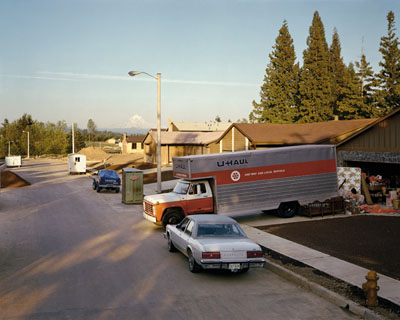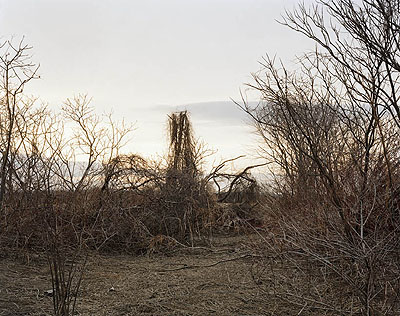
AMERICAN PROSPECTS series:
Gresham, Oregon, June 1979
Negative: 1979, Print: 2008
Digital C-Print, 107 x 133 cm
courtesy of the artist and Buchmann Galerie, Berlin
Joel Sternfeld »
The Geography of no Place: American Utopias
Exhibition: 3 May – 21 Jun 2008
Buchmann Galerie
Charlottenstr. 13/75
10969 Berlin
+49 (0)30-25899929
info@buchmanngalerie.com
www.buchmanngalerie.com
Tue-Sat 11-18

THE FIELDS series:
Looking North from a Cane Break, Near Walnut Trees Road, Towards Nook Road, on a Late March Afternoon, The Meadows, Northampton, Massachusetts, March 2007, 2007
Digital C-Print, 182 x 228 cm
courtesy of the artist and Buchmann Galerie, Berlin
Die Buchmann Galerie freut sich die erste Einzelausstellung des amerikanischen Fotografen Joel Sternfeld in Deutschland zu präsentieren. Der Schwerpunkt der Ausstellung liegt auf ausgewählten Arbeiten der Werkgruppen American Prospects und Sweet Earth. Ein Höhepunkt bildet eine großformatige Fotografie aus der neuen Serie The Field. Die Ausstellung erlaubt den Zugang zu einem Fotografen, dessen Einfluss auf die künstlerische Fotografie tiefgehend und weitgreifend ist. Kerry Brougher schreibt in seinem Essay Corrupting Photography: "[Sternfeld's] Entwicklung von spontanen Schnappschüssen hin zu durchdachten Kompositionen hat die Türen für eine neue Art der Fotografie geöffnet, wie sie von Rineke Dijkstra, Andreas Gursky, Thomas Ruff, Thomas Struth, Jeff Wall und vielen anderen praktiziert wird." 1978 dokumentierte Sternfeld mit einer Großformatkamera die amerikanische Landschaft in einer Weise, wie sie zuvor noch niemals aufgenommen wurde. Die Fotografien von American Prospects änderten die Art der fotografischen Praxis in signifikantem Maße. Sternfeld experimentierte mit Farbtheorien, die ursprünglich im Zusammenhang mit Architektur oder Malerei standen und wandte sie in der Fotografie an. Er griff ironisierend die jahrhundertealte Tradition der Landschaftsmalerei auf und entwickelte eine neue, postmoderne Konzeption der Darstellung in Form von narrativen Tableaux. Mit neuen Techniken, die eine wesentlich bessere Kontrolle ermöglichten, hat Sternfeld in den American Prospects 107x133 Zentimeter große Fotografien perfektioniert. Detailreichtum und Schärfe konnten somit auch in dieser Größenordnung bewahrt werden. In Sweet Earth beschäftigt sich Joel Sternfeld mit repräsentativen historischen oder gegenwärtigen Utopien; ein die Fotografien jeweils begleitender Text enthüllt die Natur des Ortes. Sweet Earth bringt zusammen, was anderweitig getrennt erscheinen mag und lässt die Gemeinsamkeiten von im Grunde individuellen gesellschaftlichen Phänomenen sichtbar werden. Während die frühen Sozialtheoretiker überwiegend aus Europa stammten, war es das lebendige Umfeld des jungen Amerikas, das wirkliche utopische Gemeinschaften hat entstehen lassen und experimentelle Utopien gedeihen ließ. Zwischen 1810 und 1850 versuchten Hunderte von säkularen und religiösen Gesellschaften mutig ein "perfektes" Leben für ihre Mitglieder zu schaffen. Im zwanzigsten Jahrhundert begann das Experimentieren erneut und kam zu einem Höhepunkt in den turbulenten Jahren des Vietnamkrieges. Einige Kommunen der späten 60er sind bis heute intakt und florieren. In den 1990er und den ersten Jahren des neuen Jahrtausends kam wiederum eine Welle der sozialen Experimente auf. Die sogenannten "Cohousing Communities", Gemeinden mit engem sozialem Zusammenhalt, wurden und werden immer populärer, mindestens 70 solcher Lebensgemeinschaften existieren bereits in Amerika und viele weitere sind im Entstehen. Gleichzeitig hat sich die weltweit rasch ausbreitende Idee einer nachhaltigen, ökologischen Siedlung, die "Ecovillages", überwiegend durchgesetzt. Sternfelds fotografische Reise durch Amerika ist die Suche nach der Wahrheit eines Landes, nicht nur wie sie in einer spezifischen Ära existierte, sondern in ihrer kontinuierlich sich weiterentwickelnden Essenz. Sie ist ein melancholisches Gedicht, aber auch eines voll Fröhlichkeit und Dankbarkeit, erkennbarer Ausdauer, ergreifender Schönheit und Entschlossenheit in ihrer manchmal spannungsgeladenen, oftmals ironischen Gegenüberstellung von Mensch und Natur, Technologie und Verfall. Joel Sternfelds Arbeiten wurden unter anderem im Art Institute of Chicago, dem San Francisco Museum of Modern Art, dem Museum of Fine Arts, Boston und dem Museum of Modern Art, New York ausgestellt. Für weitere Informationen über den Künstler und für Bildmaterial zu den Arbeiten können Sie sich gerne jederzeit mit der Galerie in Verbindung setzen.
Buchmann Galerie Berlin is pleased to announce the first solo exhibition by American photographer Joel Sternfeld in Germany. The focus of the exhibition is on selected works of the American Prospects and Sweet Earth series. A special highlight is a large scale photograph from the new series The Field. The exhibition of these pivotal works permit assessment of a photographer whose contribution to photographic art is profound and far-reaching. As Kerry Brougher states in the closing of his essay Corrupting Photography: "[Sternfeld's] shift from spontaneous snapshot to pre-determined picture-making helped open the gates for a new type of photography now practiced by Rineke Dijkstra, Andreas Gursky, Thomas Ruff, Thomas Struth, and Jeff Wall, among many others." In 1978 Sternfeld set out with a large format camera to record the American landscape in ways that it had not been previously documented. The photographs of American Prospects changed the course of photographic practice in significant ways. Sternfeld experimented with color theories conceived originally in reference to architecture or painting and applied them to photography. He brought irony to the centuries-old tradition of landscape painting calling forth a new, postmodern conception of landscape. Moving high above and back from his subjects, Sternfeld presented the contingencies of human and natural events in the form of narrative tableaux. Working with new printing techniques that have permitted far greater control, Sternfeld has perfected 42 x 52 inch prints that retain all the qualities of his exacting printing standards but permit a scale that allows fine detail and deep focus. In Sweet Earth Joel Sternfeld looks at representative historic or present American utopias; a text accompanying the images reveals the historic nature of the site. Sweet Earth brings together what might otherwise seem disparate, individualized social phenomena and makes visible the community of communities. While the early social theorists were largely European, it was in the fluid environment of young America that true utopian communities were built and utopian experimentation flourished. In the years between 1810 and 1850, hundreds of secular and religious societies bravely tried to build a "perfect" life for their members. In the 20th century, experimentation began again, reaching a fever pitch in the turbulent days of the Vietnam War. Some of the late-1960s communes still survive and continue to flourish. The 1990s and the early years of the new millennium have become yet another hotbed of social experimentation. The co-housing movement is sweeping America with at least 70 communities fully completed and occupied and numerous others planned. At the same time, the rapid global expansion of sustainable communities known as ecovillages has been widely adopted in America. Sternfeld's photographic tour of America is a search for the truth of a country not just as it exists in a particular era but as it is in its ever-evolving essence. It is a sad poem, but also a funny and generous one, recognizing endurance, poignant beauty, and determination within its sometimes tense, often ironic juxtapositions of man and nature, technology and ruin. His works were already shown amongst others in the Art Institute of Chicago, the San Francisco Museum of Modern Art, the Museum of fine Arts, Boston and the Museum of Modern Art, New York. For further information about the artist and images of the works don't hesitate to contact the gallery.